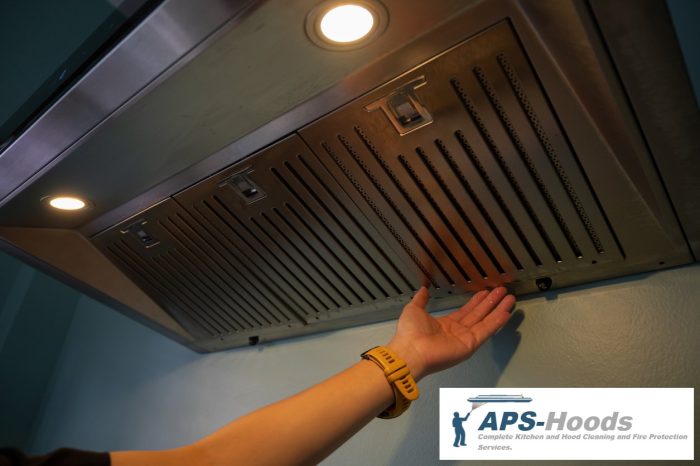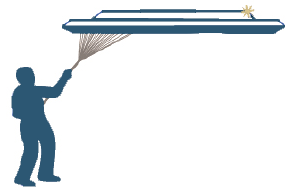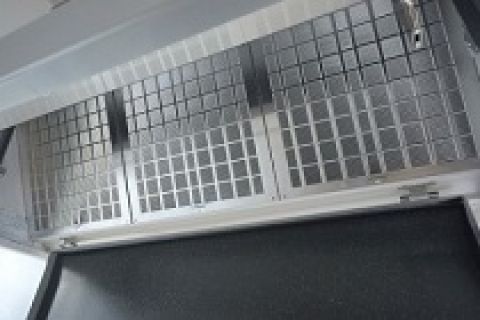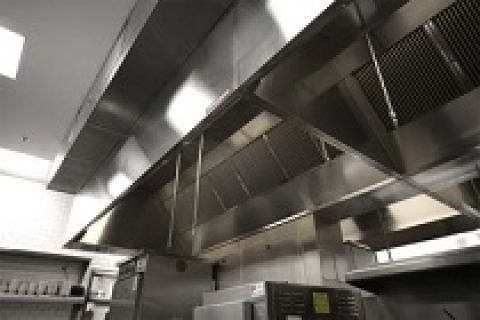How to Clean a Restaurant’s Kitchen Hood

Restaurants and commercial kitchens can’t operate without exhaust hoods. Exhaust or range hoods are an essential part of the kitchen setup. Since a restaurant produces a lot of grease, you need to install an exhaust hood system that is designed to fulfill your everyday needs. While the range hoods keep your restaurant safe and comfortable, it is crucial for you to clean and maintain the commercial kitchen hoods in a proper manner. By keeping your kitchen hoods clean, you will keep the restaurant running in a smooth manner and remain code-compliant.
At APS Hoods in Denver, CO, we specialize in commercial kitchen and equipment cleaning. If you are unfamiliar with it, let us help you understand how commercial kitchen hood cleaning is carried out.
Why Commercial Kitchen Hoods Need Cleaning
Being a restaurant owner, you should know the importance of cleaning. But you should also remain fully aware of what could happen, if you do not clean and maintain your kitchen exhaust hoods on a regular basis. Given below are some of the key reasons why exhaust system cleaning is essential.
Fire Prevention: Restaurant fires can be very dangerous. Improper cleaning or failure to clean the exhaust hoods is one of key reasons behind restaurant fires. When range hoods are left uncleaned, they gather grease and grime, which increases the risk of fire in the kitchen manifolds. Greasy fires are difficult to control and can spread very fast. That is why the first step you should take is to prevent this fire from happening by keeping the kitchen hoods clean.
Insurance Liability: If the due date of your exhaust system inspection passes and the cleaning is not done, you will be solely responsible for any kind of damage that occurs due to fire breakout. The insurance company will not cover the losses caused due to the fire. If you plan to avoid this situation, you should get the inspection conducted by professionals in a timely manner.
Productivity: Vent hood cleaning is an essential part of the overall commercial kitchen maintenance procedure. If you keep the hoods clean, the maintenance task becomes easier. As a result, the kitchen remains free from heat, smoke and contaminated air, improving the indoor air quality. Most of all, clean range hoods mean your restaurant will have maximized function and the efficiency and productivity of the kitchen employees will increase as well.
Regular hood exhaust cleaning and grease trap cleaning will keep your restaurant functioning without any hassles or interruptions. You will keep both your employees safe, healthy and happy.
What are the Components of a Commercial Kitchen Hood?
A commercial kitchen hood consists of three main parts including Type I or Type II hood, the grease ductwork and an exhaust fan. The hoods are installed over the restaurant equipment to collect and remove grease.
The process of commercial hood cleaning is an elaborate one. A trained professional starts the procedure while following each step in a proper and safe manner. If an amateur or an untrained person performs the cleaning, he will expose himself to various types of hazards and might end up causing damage to the expensive kitchen equipment and appliances in the process. That is exactly why you should rely only on specialists for the job and get all the cleaning done correctly. Every part of the exhaust hood needs to be cleaned separately.
Restaurant hood cleaning involves exhaust hood cleaning, grease trap cleaning, hood filter cleaning, hood fan cleaning, grease duct cleaning and trash chute cleaning. If you have a question in this regard, feel free to talk to one of our experts at APS Hoods, which operates in Denver, CO.
Restaurant Hood Cleaning Procedure
Following the step-by-step process of hood cleaning ensures your restaurant remains free from different kinds of safety and fire hazards. The cleaning should be conducted exactly as per NFPA standards.
Exhaust Hood Cleaning
The function of an exhaust hood is to throw contaminated air out of the kitchen. If not cleaned and removed, the contaminants deposit in the vent hood system, resulting in poor ventilation and risk of fire.
In order to clean the range hoods, the technician first removes all the components. So, he will uninstall parts such as the grease traps, hood filters, exhaust fans etc. This ensures that the cleaning of every single component is done separately and in a proper and effective manner.
The technician prepares a cleaning solution by mixing the liquid degreaser and warm water in a bucket. Then, the cleaning of the hood interior starts. After scrubbing and wiping the interior, the professional starts cleaning the exteriors of the range hoods. In order to deliver a thorough clean, kitchen cleaning companies use a wide range of methods and tools during the process. At APS Hoods, we regularly perform commercial restaurant cleaning and vent hood cleaning and understand the varying needs of every cooking facility with absolute clarity. With our certified and trained technicians by your side, you can feel confident that the exhaust hood cleaning of your restaurant facility will be conducted with full professionalism.
Grease Trap Cleaning
Grease traps are installed in order to prevent greasy substances from getting into the ventilation and the sewage system.
There are different sizes of grease traps. So, the frequency of these devices depends on their actual size installed in a restaurant, cafeteria, dining center etc. If you neglect grease trap cleaning, these devices will start to overflow. This, in turn, will take a toll on the entire exhaust hood system.
In order to clean the grease trap, the technician first uninstalls it or removes it from the range hood. Then, the scrubbing and degreasing of this device is conducted. It is crucial to not let the removed grease deposit pass through the drain. In fact, all the greasy material should be collected in a container. After scrubbing, the grease traps are placed into a solution. After 10-15 minutes, the devices are taken out of the solution and then air-dried before reinstallation.
Kitchen Hood Filter Cleaning
Hood filters are a crucial part of the exhaust hood system. The role of these filters is to filter the air that is pushed through the hood system. In the absence or failure of these filters, grease will deposit inside the air ducts. This, in turn, could become a potential fire hazard creating risk for everyone working inside the kitchen as well as the visitors who come to dine in the restaurant.
Since hood filters catch and remove the particulate matter in the air, they need proper cleaning on a regular basis. When it comes to cleaning the kitchen hood filters, the technician will first uninstall the component from the range hood. Once separated from the unit, it becomes easy to clean the filters. Once the degreasing solution is ready, the technician puts the filters into it. Based on specific needs, the filters can be left to soak in the solution for several hours. After removal from the solution, the hood filters get scrubbed and rinsing until fully clean.
Before the filters are ready to reinstall, the technician makes sure the component is fully dry. Giving hood filters a thorough clean in a timely manner keeps the entire kitchen exhaust hood system in good shape.
Hood Fan Cleaning
Located inside the range hood, the exhaust hood fan pulls the air through the filter. So, the device plays a crucial role in getting rid of the heat, steam or smells from the commercial kitchen. It is due to these fans that the distribution and flow of the air in the kitchen remains balanced. Based on the type of exhaust hood system you have installed in your cooking facility, there may be a few or more fans inside the hood. It is very important to keep the hood fans clean, just like other components of the kitchen exhaust or range hood system.
To clean the hood fan, the professional uninstalls the device first. Once the fans are separated from the hood system, it becomes much easier to clean and degrease them in a proper manner.
After the fan blade covers are removed, the technician gets access to each one of the fan blades. Now, the fan blades are detached as well. In this way, the technician can clean each fan blade individually. If your hood system has several fans, it will be important to not fix up all the blades with one another. The technician leaves all the blades in the cleaning solution to soak. After soaking has been done, the fan blades are taken out the solution and left to dry. Once fully dried, the technician starts to reattach the hood fan blades, one after another.
Finally, the blower is put back into the kitchen hood for reinstallation. This is how the hood cleaning procedure is completed.
Kitchen Hood Duct Cleaning
All the hood ducts need thorough cleaning to function with maximum efficiency. Those docs that lie out of the range will be easy to clean. To properly clean all the ducts, you will need the help of experienced professionals. Trained technicians will clean all the ducts including the easily reachable ones as well as those that are hard to reach. Using the cleaning solution, the interiors and the exteriors of the hood ducts will be scrubbed and washed and cleaned.
Once duct cleaning has been completed, the ducts will be left to dry. To know more about the hood ducts and the methods used to clean them, get in touch with one of our professionals at APS Hoods in Denver, CO.
How Often Should Commercial Kitchen Hoods be Cleaned?
The frequency of hood cleaning varies from one type of restaurant to another. Many restaurants are required to carry out the exhaust hood cleaning at the interval of every three months. To find out the exact frequency, three key factors play a crucial role including the menu items, amount of cooking and the type of cooking equipment and appliances you use in the kitchen.
A monthly hood inspection is required for those restaurants that use solid fuel for cooking operations. Likewise, you may need to set up a monthly, quarterly, semi annual or annual hood cleaning schedule.
To find out more about the frequency of restaurant hood vent cleaning, reach out to one of our commercial cleanup experts. At APS Hoods, we will first evaluate the specific cleaning needs of your restaurant, bar, hotel, dining center, cooking facility etc. Then our experts will develop the most ideal cleaning schedule for your business to eliminate potential safety hazards and stay compliant to the fire safety codes as outlined by the National Fire Protection Association.
Commercial Kitchen Cleaning Services
A restaurant’s kitchen hood cleaning is different from general cleaning. If you lack the knowledge and experience to do the exhaust system cleaning yourself, you should seek the help of professional bar and restaurant cleaning services. Trained professionals specialize in commercial kitchen hood cleaning and carry out the procedure while abiding by all the necessary codes and regulations. Professionals will use the right set of tools as well as correct methods to properly clean every component of the exhaust hood system installed in your kitchen.
In addition to cleaning, you can hire a restaurant cleaning company for the inspection and maintenance of hood systems too. To get more details on these services, get in touch with one of our specialists.
Still Have a Question?
If you are a restaurant owner, you should never ignore or delay the inspection and cleaning of your exhaust hood system. Uncleaned hoods create serious safety hazards, putting the safety and health of your employees and guests at risk and putting you in violation of the essential codes. If you have an additional question or want to schedule restaurant hood cleaning in Denver, CO, reach out to APS Hoods. Our bar and restaurant cleaning services are designed to help you run your business smoothly by eliminating potential risks of fire hazards.
For your free consultation, you can reach our Denver office via a phone call or write to us an email using the contact form.
Along with APS Hoods, we also run Hood Builder and Nationwide Fire Protection to bring you all the restaurant design-related services in one place. For your free consultation with one of our specialists, you can either call our office phone number or write to us using the contact form.






